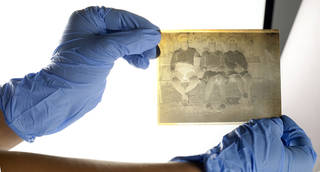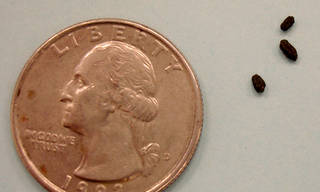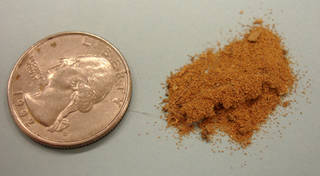
Preservation Self-Assessment Program
Instant B&W Photographs
Risks of Handling/Use
Generally, handling and use heightens the risk of damage to your materials, be it through neglectful handling (e.g. touching photo emulsion with bare hands) or irresponsible operation of access equipment. This is a risk posed by patrons and staff alike, intentional or not.
Handling and Collections Care
One of the easiest areas to implement protections for collections is through careful handling and sensible collections care. The unfettered use and handling of materials heightens the general risk of damage--be it through neglectful handling (e.g. touching photo emulsion with bare hands) or irresponsible operation of access equipment. Whether intentional or not, this is a risk posed by patrons and staff alike.
Examples of neglect, mishandling, and mismanagement include:
- Pressure-sensitive (such as "Scotch®" brand) tape to mend tears.
- Permanent or volatile inks used to label documents (even the back side).
- Folding materials to fit into a given box or enclosure.
- Poor handling: Not washing and drying hands before handling fragile documents; or not using gloves when handling materials that could be damaged by contact with oils on the skin (for example: gloves must always be worn when handling metals).
- Inadequate storage or exhibit environments, such as areas with excessive climate swings or the use of poor display mounts.
- Inadequate packaging/padding for shipping
- Lack of bibliographic control over holdings, which has led to the harmful and excessive use of unique or vulnerable items.
General Recommendations:
- Use archival-quality folders, boxes, sleeves, and other enclosures to support and house materials of differing shapes and sizes. Avoid use of acidic containers such as brown paper bags and shipping or moving boxes.
- Use only Photographic Activity Test (PAT)-compliant storage enclosure materials for valuable photographic materials.
- Wear gloves (either cotton or nitrile) while handling archival photographic emulsion materials and museum objects.
- Avoid wearing cotton gloves while handling particularly fragile or slippery items, since gloves can hamper tactile senses and lead to accidentally dropping and breaking objects.
- Handle fragile materials as little as possible.
- Use clean, dry hands with carefully trimmed nails to handle materials (even when wearing gloves).
- Use both hands and ask for assistance when handling/moving oversized materials.
- Remove jewelry and accessories, including anything hanging around the neck or clothes that may inadvertently come into contact with and damage materials, such as: necklaces, headphones, glasses hanging around the neck, nametags, scarves, rings, watches, bracelets, ties, loose sleeves, and belts. Avoid wearing loose clothing.
- During transport, use enclosures, supports, book carts, and other equipment as appropriate to minimize the risk to materials. Use materials like foam and snake supports to ensure that items are supported and do not come in contact with other items or with the sides of carts during transport. Always ensure sufficient assistance while transporting items.
- Only use pencils for direct labeling (e.g. on a photo verso) of paper, AV, and photographic materials or folders/enclosures. Never use or carry pens around items and materials.
- Ensure that patrons know and understand guidelines on proper handling of all fragile materials.
- Ensure that staff, volunteers, and patrons are adequately trained in handling collection materials.

Additional Copies
The use of additional copies for reference or display purposes is highly recommended, particularly if the item is an original or valuable. This provides broader access to the content while also protecting the original document from user wear and tear or environmental factors.
Recommendations for care of original object:
- Ideally, originals should be used once to produce an access copy, facsimile, or surrogate;
- Copies would then be put to use by the institution in place of the original, sustaining the wear and tear of patron use or prolonged exhibition.
To learn more about best practices for use and access, including resources for creating digital surrogates, see Use & Access in the User-Manual.
Orientation in Storage
Store vertically with dividers between each print. May also be stored horizontally, especially large prints. Enclosures and folders may be stored in hanging files or archival storage boxes.
Storage Container
Dye-transfer prints should be stored in nonbuffered storage materials, since the prints are stabilized at an acid pH (acetic acid bath). Each print should have its own enclosure to protect it from dust, handling damage, and changes in environmental conditions.
This enclosure may be a paper (archival-quality, acid-free) or plastic (uncoated polyester, polyethylene, polypropylene, cellulose triacetate) sleeve, envelope, or wrapper. Include a rigid secondary support within this enclosure. Position image material away from seams in paper enclosures. Seams should be on the sides of the enclosure, not down its center. Enclosures should be stored in hanging file folders or archival storage boxes. Wood cabinets should be avoided. Enameled steel, stainless steel, or anodized aluminum are preferred.
All storage materials should pass the Photographic Activity Test (PAT) as specified in ISO Standard 18916:2007.
Labeling
If your item has any kind of labeling on the container, the item itself, or any related material, we highly recommend that you return to the Basic Info section and enter this information in the appropriate field(s).
Labeling on a container or on the item itself, if it is in fact correct, can offer important clues about its content. If you are replacing a container that holds labeling information, it is important to transfer this information to the new container or label. Be sure to copy down any titles, dates, or other data found on these items and save your notes. Container labels should be used with caution as they are frequently reused or easily switched by accident.
For sleeves and folders especially, remember that it's generally best to label with a no. 2 pencil. If ink must be used (i.e. on a plastic enclosure), use an archival pigment-ink pen (e.g. Micron).
Physical Damage
Regardless of its acidity and inherent vice, all paper is susceptible to tearing and other forms of mechanical damage. Fiber-based prints will have a tendency to curl, usually as a result of fluctuating humidity.
Care must always be shown when handling prints to avoid abrasion, scratching, and surface wear. Do not attempt to clean print surface. The white border found around instant photos should never be cut off or removed; it provides a barrier to atmospheric pollutants, and its removal would also weaken the structural integrity of the photograph. Unmounted prints may curl. A stable environment should also prevent the emulsion from delaminating.
Mold / Pest Damage
The gelatin binder of a photographic emulsion is an especially good nutrient for mold. If your item is exhibiting white or brown patches or if you see a lattice-like growth along the edges, you are most likely viewing mold. Negatives stored in hot, humid environments are most vulnerable to mold, mildew, and fungus contamination. Mold will typically damage the edges of photographic material first. If mold has eaten into the emulsion, the item will be noticeably and irreparably damaged, exhibiting feathery-like distortions or dull spots on the image. Mold can be removed through cleaning and then storing the items in a cold, dry environment, but this should be done responsibly.

Pests like insects and rodents tend to like paper and textile materials. High humidity (higher than 68% RH) promotes mold growth and insect infestation, both of which can cause permanent damage. When assessing the exposure of your collections to pests, it is necessary to look not just at the materials themselves and their containers, but also at the larger environment. Insects and rodents tend to leave droppings in areas they inhabit. Insects tend to leave behind a substance called frass, which is the undigested fibers from paper. If you see droppings and/or frass in the storage area, it is a strong sign that your materials are being exposed to pests. Small, irregular holes in paper-based enclosures are also a sign that pests have attacked your materials.
Some tips for reducing your materials' exposure to pests are to refrain from eating anywhere near your collections materials. Crumbs and food waste draw pests, so eat far from your collections. Another tip applying to both pests and mold is to be cautious about donated materials when you receive them. Pests and mold can hitch a ride into your facility on these materials, so having a good, clean staging area where you can inspect donated items for, among other things, pest and mold evidence can help you reduce your storage environments' exposure to both.


Instant Films
Peel-apart


B&W instant photos are generally of the peel-apart variety. B&W integral photos do exist (Polaroid type 600) but are rare.
All peel-apart prints have some tendency to curl in toward the image. Occasionally, there will be noticeable defects at the image's edge from an uneven spread of developer between the negative and receiving layers during processing. The peel-apart print is generally more stable than its integral counterpart. However, for prints requiring hand-coating (all B&W before 1970), the image is extremely susceptible to damage prior to application. Once coated, the image is rather stable. Localized fading of the image and brownish-yellow streaking may occur if the image was coated improperly.
Coated peel-apart prints are exclusively B&W. Initially known as the Polaroid Land process, this peel-apart print requires a protective coating/stabilizer after processing. The image is pulled apart from the negative film and is subsequently hand-coated. Until 1970, all Polaroid B&W films required this protective polymer coater.
Integral


The integral format in particular can be easily identified by its unproportional border, with the lower white border larger than the others to house the chemical pods used to process and create the image.
Integral prints may be color or black and white. In an integral print, the negative and positive components comprise a single unit, which contains layers of all the necessary processing chemicals. Polaroid's SX-70 integral color format contained as many as thirteen interdependent layers.
Developing chemical pods are located adjacent to the image and account for the characteristic unproportional white border. "Polaroid", "SX-70", or other film type backprint markings often appear after 1968. For the less common Kodak formats produced from 1976 to 1985, "Kodak'" and "PR10" backprints may be present.
Integral prints will fade significantly faster than peel-apart prints. Instant color on the whole will fade noticeably upon exposure to intense light levels.
Cracking and Distortion
In an instant photo process, all the chemicals necessary to create the print are self-contained either within or facing the support material; they are activated when the exposure is made and the image is squeezed through rollers ejecting it from the camera. Instant photo processes do not incorporate liquid baths to remove the silver compound, which remains on the print. If an instant photo is not stored properly, it is possible for the silver image to migrate across the support and to distort the content.
Instant photos are also succeptible to cracking and crazing as a result of fluctuating humidity. Instant photos manufactured before 1976 may also exhibit cracking in the image receiving layer beneath the transparent print cover sheet.
Paper Decay
Paper is sensitive to light and water exposure, high humidity, and high heat. Exposure to light and/or heat will accelerate deterioration in the form of yellowing and sometimes embrittlement.
Acidic paper (pH below 7.0) commonly exhibits both deteriorative traits. Colored media on the paper support will fade rapidly. Water exposure can ultimately lead to desiccated or brittle paper, making it more easily torn or damaged through handling. Fluctuating temperature and RH may result in warping and cockling of the paper surface. High humidity (higher than 68% RH) promotes mold growth and insect infestation, both of which can cause permanent damage.
According to a study by the Library of Congress, even pH neutral papers will become increasingly acidic over time. This is due to the fact that cellulose naturally generates acids as it ages. Papers, including book leaves, that are darker and more brittle along their edges than center demonstrate an absorption of airborne pollutants that have formed acids.
Soil and dust may become ground into paper fibers, permanently soiling or staining the paper surface. Foxing is a common form of paper deterioration, which manifests as reddish-brown spots or blotches that appear embedded in the paper surface. Foxing is caused by a number of factors but is commonly spurred along by high humidity.
Fading, Staining, and Discoloration
Generally, B&W instant photos commonly fade around the edges and develop discolored patches throughout the print. Properly coated peel-apart prints are resistant to abrasion, but more susceptible to chemical contaminants. B&W photos manufactured by Polaroid before 1970 required the print to be hand-coated with a protective polymer. If applied unevenly, uncoated areas may develop yellowing, loss of detail, and increased sensitivity to abrasion.